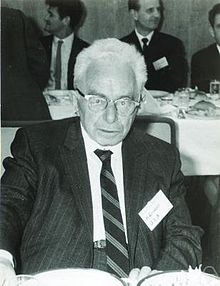Type a search term to find related articles by LIMS subject matter experts gathered from the most trusted and dynamic collaboration tools in the laboratory informatics industry.
Richard Courant | |
|---|---|
 Courant in 1969 | |
| Born | January 8, 1888
|
| Died | January 27, 1972 (aged 84) New Rochelle, New York, United States |
| Citizenship |
|
| Alma mater | |
| Known for |
|
| Scientific career | |
| Fields | Mathematics |
| Institutions | |
| Thesis | On the application of Dirichlet's principle to the problems of conformal mapping (1910) |
| Doctoral advisor | David Hilbert |
| Doctoral students | |
Richard Courant (January 8, 1888 – January 27, 1972) was a German-American mathematician. He is best known by the general public for the book What is Mathematics?, co-written with Herbert Robbins. His research focused on the areas of real analysis, mathematical physics, the calculus of variations and partial differential equations. He wrote textbooks widely used by generations of students of physics and mathematics. He is also known for founding the institute now bearing his name.
Courant was born in Lublinitz, in the Prussian Province of Silesia (now in Poland). His parents were Siegmund Courant and Martha Freund of Oels. Edith Stein was Richard's cousin on the maternal side. During his youth his parents moved often, including to Glatz, then to Breslau and in 1905 to Berlin. He stayed in Breslau and entered the university there, then continued his studies at the University of Zürich and the University of Göttingen. He became David Hilbert's assistant in Göttingen and obtained his doctorate there in 1910. He was obliged to serve in World War I, but was wounded shortly after enlisting and therefore dismissed from the military. Courant left the University of Münster in 1921 to take over Erich Hecke's position at the University of Göttingen.[2] There he founded the Mathematical Institute, which he headed as director from 1928 until 1933.
Courant left Germany in 1933, earlier than many Jewish escapees. He did not lose his position due to being Jewish, as his previous service as a front-line soldier exempted him; however, his public membership in the social-democratic left was reason enough (for the Nazis) for dismissal.[3]
In 1936, after one year at Cambridge, Courant accepted a professorship at New York University in New York City. There he founded an institute for graduate studies in applied mathematics. The Courant Institute of Mathematical Sciences (as it was renamed in 1964) is now one of the most respected research centers in applied mathematics.[4]
Courant and David Hilbert authored the influential textbook Methoden der mathematischen Physik, which, with its revised editions, is still current and widely used since its publication in 1924. With Herbert Robbins he coauthored a popular overview of higher mathematics, intended for the general public, titled What is Mathematics?. With Fritz John he also coauthored the two-volume work Introduction to Calculus and Analysis, first published in 1965.[5]
Courant's name is also attached to the finite element method,[6] with his numerical treatment of the plain torsion problem for multiply-connected domains, published in 1943.[7] This method is now one of the ways to solve partial differential equations numerically. Courant is a namesake of the Courant–Friedrichs–Lewy condition and the Courant minimax principle.
Courant was an elected member of both the American Philosophical Society (1953) and the United States National Academy of Sciences (1955).[8][9] In 1965, the Mathematical Association of America recognized his contributions to Mathematics with their Award for Distinguished Service to Mathematics.[10][11]
Courant died of a stroke in New Rochelle, New York on January 27, 1972, aged 84.[12]
Commenting upon his analysis of experimental results from in-laboratory soap film formations, Courant explained why the existence of a physical solution does not obviate mathematical proof. Here is a quote from Courant on his mathematical perspective:
Empirical evidence can never establish mathematical existence–nor can the mathematician's demand for existence be dismissed by the physicist as useless rigor. Only a mathematical existence proof can ensure that the mathematical description of a physical phenomenon is meaningful.[13]
In 1912, Courant married Nelly Neumann, who had earned her doctorate at Breslau in synthetic geometry in 1909. They lived together in Göttingen until they were divorced in 1916. She was later murdered by the Nazis in 1942 for being Jewish.[14]
In 1919, Courant married Nerina (Nina) Runge (1891–1991), a daughter of the Göttingen professor for Applied Mathematics, Carl Runge (of Runge–Kutta fame).
Richard and Nerina had four children: Ernest, a particle physicist and innovator in particle accelerators; Gertrude (1922–2014), a biologist and wife of the mathematician Jürgen Moser (1928–1999); Hans (1924-2019),[15][16] a physicist who participated in the Manhattan Project; and Leonore (known as "Lori," 1928–2015), a professional violist and wife of the mathematician Jerome Berkowitz (1928–1998) and subsequently wife of mathematician Peter Lax until her death.[17]